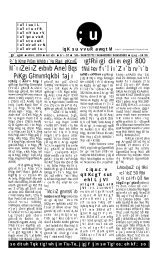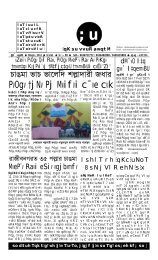Create successful ePaper yourself
Turn your PDF publications into a flip-book with our unique Google optimized e-Paper software.
and non-indigenous minorities groups alike,<br />
these are rights of individuals, and not that<br />
of a collectivity that pertains to the group as<br />
a group. It therefore fails to address several<br />
aspects of collective rights – e.g., with regard<br />
to customary law and traditional justice<br />
systems, customary land and territorial<br />
rights, right to self-determination and selfgovernment<br />
- which, conversely, are adequately<br />
addressed in the UN Declaration on<br />
the Rights of Indigenous Peoples (2007), and<br />
to a lesser extent, in the ILO Conventions<br />
No. 169 and 107. The Vienna Declaration<br />
and Programme of Action adopted at the<br />
World Conference on Human Rights in<br />
Vienna in 1993 addresses the rights of ‘persons<br />
belonging to minorities’ and the rights<br />
of ‘indigenous people’ in separate paragraphs.<br />
INDIGENOUS PEOPLES UNDER IN-<br />
TERNATIONAL LAW<br />
‘Indigenous Peoples’, and to a lesser extent,<br />
‘indigenous people’, are established beyond<br />
doubt as the preferred globally accepted terminology<br />
– as invoked in several United Nations<br />
instruments - to refer to groups that<br />
are, or were, referred to as ‘aboriginal’,<br />
‘tribal’, ‘hill tribes’, ‘scheduled tribe’, ‘ethnic<br />
minorities’, etc.. The World Bank and<br />
regional development banks too adopt the<br />
same language. As in the case of minorities,<br />
there is no formal definition of indigenous<br />
peoples in any international human rights<br />
instrument. The ILO Convention No. 107<br />
(ratified by Bangladesh) provides some criteria<br />
to identify ‘indigenous’ and ‘tribal’<br />
populations. The former are those that are<br />
(i) descended from historical population<br />
groups that inhabited the country at the time<br />
of conquest or colonization; and (ii) who live<br />
BB vIyUElt gIEsgIH<br />
<strong>2011</strong> BB 15 BB<br />
more in conformity with the social, economic<br />
and cultural institutions of these historic<br />
groups than with the ‘institutions of the nation<br />
to which they belong’. The CHT indigenous<br />
peoples fulfill both criteria on the nature<br />
of the institutions to which they belong<br />
and with regard to their presence in the concerned<br />
territory at the time of conquest (1787<br />
by the British East India Company) and colonization<br />
(1860: annexation of CHT to Bengal<br />
by the British Indian government).<br />
Perhaps one the most widely accepted<br />
‘working definitions’ of indigenous<br />
peoples is the one provided by UN Special<br />
Rapporteur Jose Martinez Cobo, who includes<br />
the following criteria to identify indigenous<br />
peoples: (i) continuity with pre-invasion<br />
and pre-colonial societies; (ii) comprising<br />
non-dominant sectors of society; and<br />
(iii) determination to preserve, develop and<br />
transmit to future generations their ancestral<br />
territories and ethnic identity “in accordance<br />
with their cultural patterns, social institutions<br />
and legal systems”. If we summarize<br />
the above criteria, the following may<br />
emerge as the most crucial ones: (a) exclusion<br />
from (or only marginal inclusion in) the<br />
modern state-building and formal development<br />
processes; (b) continuing non-dominance<br />
(or marginalization) in major decisionmaking<br />
processes; (c) presence of customary<br />
law and traditional governance institutions;<br />
(d) close attachment to an ancestral or<br />
historical territory; and (e) geographic concentration<br />
in those territories. All of these<br />
criteria are applicable to the indigenous<br />
groups in the CHT, and in the plains of<br />
Bangladesh. Moreover, when it ratified the<br />
ILO Convention No. 107 in June, 1972, the<br />
Government of Bangladesh did not raise any<br />
objections to the use of the word ‘indigenous’.









